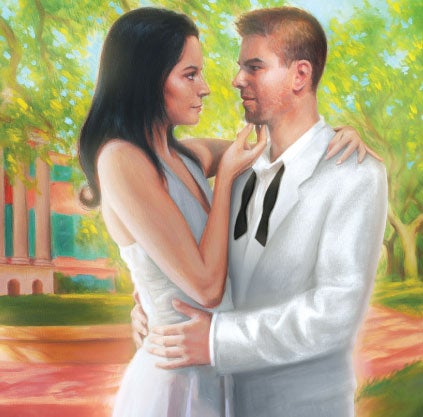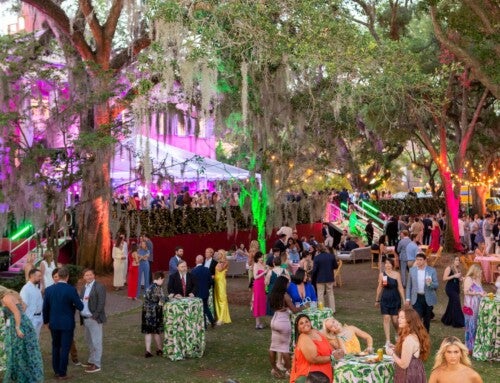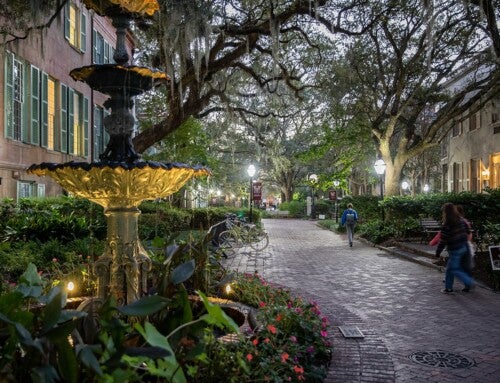 No longer just a crutch for bored housewives, romance novels have undergone a revolution in the past few decades, sprouting subgenres that run the gamut from Christian love stories to the paranormal. These days, romance novels offer happy endings to satisfy every type of reader, with many being penned by College alumni and staff authors.
No longer just a crutch for bored housewives, romance novels have undergone a revolution in the past few decades, sprouting subgenres that run the gamut from Christian love stories to the paranormal. These days, romance novels offer happy endings to satisfy every type of reader, with many being penned by College alumni and staff authors.
by Jason Ryan
Illustrations by Max Miller ’02
Conseula Francis read her first romance novels as a teenager, sneaking the steamy stories away from her mother’s bookshelf. Like many curious teenagers, she was interested in sex. And, if you wanted to stay a good girl, books were a safer bet for obtaining an education in the birds and the bees than real, live boys.
By the time she got to college, Francis had moved on to other genres of fiction. As a grown black woman, she now found most romance novels less than satisfying. In the first place, there were no black heroines in any romance novels she encountered. In the second place, the white, female protagonists who did fill the pages were not exactly women to be envied. Most of the time they were virgins waiting around to be rescued, hoping a strong and handsome man would lift them from their helpless predicament, whether it was heartbreak, poverty or danger.
Besides, Francis felt she needed to drop the love stories to make time for serious literature.
“Clearly, I was above romance novels,” she remembers, “in the snotty ways of English majors.”
Years later, while working as an English professor at the College and exploring the alternative genres of slash fan novels and urban fiction, Francis rediscovered romance novels. To her surprise, things had changed. Gone were the passive, almost exclusively Caucasian maidens. In their place were bold women of every color, shape and sexual orientation, with all sorts of romantic preferences and fetishes. The variety was astounding. 
“Love stories with werewolves, love stories in space, love stories in Scotland, love stories with pirates. Whatever type of romance story you want to read, the market is delivering it with regularity,” says Francis.
Francis was so encouraged by what she read that she began sharing modern romance novels with her mother – a reversal from her teenage days. Her mother was “floored,” says Francis. Finally, they thought, there were books about ordinary black women and their love lives.
“It’s nice to be able to read a story in which someone has imagined a person like you can fall in love,” says Francis.
Recipe for Success
Francis and her mother are not alone in their appreciation of these love stories. Sales of romance novels surpass $1 billion each year, making it the most lucrative category of book publishing and representing about 13 percent of all fiction sold. Earlier this year, E.L. James’ Fifty Shades erotica trilogy sold its 100 millionth copy.
According to the trade association Romance Writers of America, about 75 million people read at least one romance novel each year. Most of these readers – somewhere near 85 percent – are female. The majority of them are also middle aged and college educated, dispelling the notion, says Francis, that fans of romance novels are “mindless housewives eating bonbons who can’t tell the difference between fantasy and reality.”
No matter what type of romance novel readers pick up, whether NASCAR-themed, dinosaur erotica or lust among the Amish (yes, these all exist), nearly every book features two things: a central love story and an ending described as happily ever after, or HEA.
And what if one of these things is missing?
“Pitchforks. Readers will find my house,” says Savannah Frierson, a romance writer who works as an administrative assistant at the College’s Avery Research Center for African American History and Culture.
Frierson is hardly being facetious. In the world of romance novels, there is an understanding between author and reader that things will turn out all right, that love will conquer all. Readers trust authors to deliver a heartwarming, and sometimes arousing, story to lift their spirits.
“People don’t want to be so heavy all the time. People want to escape,” she says.
On the surface, such expectations might seem constraining to an author. Yet romance writers say the challenge is working within the framework to craft a tale that satisfies these basic rules while remaining compelling. It’s not ultimately so much what will happen, but how it will happen.
Besides, what’s wrong with guaranteeing a happy ending? If you want misery, turn to current, mainstream literary fiction, says romance author Kieran Wray Kramer ’85, where oftentimes “pessimism reigns, despair is king. You know, what’s there to hope for?
“I write happy endings because I believe in them,” Kramer continues. “I believe in the power of good and the power of love. I do like inspiring people.”
Following stints working for the CIA and as a teacher, Kramer became a mother of three, moving often because of her husband’s Navy career. She tried her hand at novel writing a few times over the years, but was never published. Then, in 2008, her husband deployed to Afghanistan. Kramer decided she would try again to get a novel published, and this time stick with it. To her delight, her period romance When Harry Met Molly was published in 2010. Eight more titles soon followed.
“I realized time was passing and I was a lot of talk and not a lot of action,” she says. “You just have to persevere.”
Similarly, Catherine Woods Mann ’85 waited until her youngest child entered preschool before trying her hand at writing. She’s been wildly successful, with 50 books published. Many of her romance novels, such as those in her Wingmen Warriors series, feature the military. As the wife of an Air Force colonel, it’s a subject close to her heart.
“There’s an authenticity that comes with writing what you love and know,” says Mann. Other times, her books explore challenges associated with abandoned animals, breast cancer, Down syndrome or becoming a war widow.
“It’s not just about falling in love, it’s about overcoming obstacles,” she says.
Beyond these varied types of context, perhaps most surprising to readers who have not revisited romance novels in a long time is the fact that in today’s novels, men and women now stand on equal footing.
“People are finding out romance novels of today are about empowerment,” says Mann. “It’s not about a hero coming to rescue you, it’s about rescuing each other. A true partnership.”
Sex Sells
But a couple’s equal footing falls away, at least temporarily, when one lover ties the other up and the spanking begins. If you’re interested in bondage, discipline and sadomasochism, many of today’s erotic romance novels offer that, too. In Captured in Croatia, by Christine Ferrell Edwards ’98, the heroine is suspended from a punching bag and whipped with a belt before she eventually makes love to her captor. In Nordic Lessons, Edwards writes of a Norwegian motorcyclist who introduces an English tourist to bondage. Edwards says her readers demand alpha male characters that are unpredictably sensual and animalistic.
“We all have the fantasy of the Viking or the biker. Who wants to get it on with the uptight professor?” asks Edwards.
At the same time, Edwards says her readers demand strong, feisty heroines who can stand up to imposing men. Her  characters trade control back and forth, their turns of dominance inevitably weakened by crippling desire. And with Edwards, you have to be patient before the lovemaking scenes begin.
characters trade control back and forth, their turns of dominance inevitably weakened by crippling desire. And with Edwards, you have to be patient before the lovemaking scenes begin.
“Fine erotica is the development of the characters and the buildup of passion so that the readers are on the edge of their seats,” notes Edwards, the author of six books, who says her sales skyrocket on Friday and Saturday nights.
For other romance writers, there may be less of a focus on physical intimacy, either by design or because sex scenes can be difficult to write. Kramer says that when she turned in her first draft of a romance novel, an editor in New York told her: “This is not a romance, there are no sex scenes!” Kramer made some edits.
Love scenes were similarly challenging to write for College staff member Frierson, who sees more to plumb in the emotional aspects of a relationship.
“The biggest part of the romance is the feelings that two people have for each other,” she says. “There’s only so many ways you can write two people having sex.”
On the other hand, Frierson admits, it would be disingenuous to focus only on courtship and not to spend time describing a couple’s intimate moments. In the world of romance writing, she says, “there needs to be sex, there needs to be open-door sex, unless you’re a Christian writer. The more they do it, the better it is.”
More Than Love
Since graduating from Harvard University in 2005, Frierson has self-published seven books, using her work to explore nontraditional relationships. In Go With Your Heart, Frierson writes about an interracial romance between a Choctaw Confederate soldier and an enslaved black woman. In Loose, co-written with BJ Thornton, she details a three-way relationship between a queer woman and a married couple. Frierson acknowledges that sometimes nontraditional storytelling carries the risk of lower sales.
“I’m proud of this story, but it’s going to take my readers a minute to get used to this story,” Frierson says of Loose. As an author, “you want to go and try something else, but your readers might not follow you there.”
But Frierson argues these types of romances are not so unusual – they’re just underrepresented in the world of romance novels, much like there had historically been an absence of well-developed black characters in love stories. By discussing these types of romance, they are legitimatized.
In a broader sense, romance novels legitimize women’s sexuality in general. The novels provide a place where women openly explore their sexual emotions, something long considered taboo in traditional society.
“There’s an awful lot of shame when talking about a woman’s sexuality,” says Kramer. “I applaud romance novels for giving women the chance to explore this in a safe way.”
Kramer is also proud that readers have written to explain how her books help recharge their libidos and that her depiction of healthy romantic relationships has encouraged them to foster their own. Similarly, Edwards was flattered when she learned that a couple she was acquainted with read her books aloud to each other in bed. For Mann, romance novels are first and foremost a medium for generating joy and bliss. 
“I like things that celebrate happily ever after. We live in a world that doesn’t celebrate it enough,” says Mann.
Happily Ever After
Ultimately, successful romance novels deliver a few things to their readers. They are entertaining. They validate romantic feelings and experiences felt by the reader. And they give hope to the lovelorn.
As much as things have changed in the world of romance fiction, the important things have stayed the same. No matter who is falling in love, whether reunited high school sweethearts or a cavewoman and a triceratops, the pair will live happily ever after. And that means readers will be satisfied, too.
As Frierson says of the essential appeal of the romance novel: “At least for 10 minutes, I’m going to feel as happy as these people at the end of the book.”
FROM THE ARCHIVES: Robert Marks: A Legacy of Literary Lust
Robert Marks (1907–1993) dropped out of the College not once, but twice. Before his second departure, the College president even sent him a personal letter:
“The College of Charleston,” wrote Harrison Randolph, “would deem it a pleasure if in the next term you did not re-enroll.”
Marks did not seem too bothered by the slight.
“School was a bore,” said Marks, who was kicked out of Yale University, too.
In light of Marks’ academic struggles, his mother took him to psychologists. They said her son would either be a prodigy, or nothing at all. Marks’ mother feared the latter. Yet her instincts were wrong. Marks would become one of the country’s leading magazine writers and journalists. And late in life, he penned a series of 14 best-selling erotic novels centered in Charleston.
Marks grew up on Rutledge Avenue, across from the female preparatory school Ashley Hall, where he took violin lessons. For a man who later wrote so appreciatively of women, especially their anatomy, the youngster regarded his proximity to the school as a curse.
“I was terrified of walking through that gate and past all those giggling girls,” Marks said. “I was a lonely, anxiety-ridden little boy and early on I discovered books were more interesting than life. I looked up to those who were sophisticated with book knowledge.” 
After neglecting his studies at the College and Yale, Marks moved to New York and began a freelance-writing career, just barely scraping by and accepting any work he could find.
It was the beginning of a prolific and extremely successful career. In time, Marks ghostwrote Elsa Maxwell’s famous society column, became the aviation and automotive editor for Esquire and traveled the world interviewing celebrities, including beauties like Sophia Loren, Jayne Mansfield, Kim Novak and Audrey Hepburn.
An enterprising and hungry journalist, Marks was often published numerous times in a single issue of a magazine, requiring he employ a number of pseudonyms. He also recycled his material, submitting assorted versions of the same article to different publications.
“For Esquire I would write high serious with a touch of humor, sophisticated,” said Marks. “For Reader’s Digest, I wrote like a telegram with no long words.”
Marks was also interested in science. He co-invented a logic machine and was a professor of cybernetics at the New School of Social Research in New York (where he also earned, in three years, a bachelor’s, master’s and Ph.D.). Marks was the leading authority on Buckminster Fuller, a futuristic architect, inventor and intellectual. Whenever Marks needed money, he admitted, he wrote another article on Fuller, ultimately penning 40 articles about his friend.
Despite Marks’ popularity among magazine editors, his writing ideas were sometimes deemed out of bounds. After pitching a story on “The Life and Loves of a Midget,” Marks received a rejection letter from Cosmopolitan.
“The enclosed outline was given serious consideration, but the reaction here among the girls was a definite feeling of revulsion. We have therefore decided to drop the idea,” wrote associate editor A.E. Hotchner in 1949.
Marks wrote 40 books, too, on subjects as diverse as mathematics, chess, Italian civilization, photography and hypnotism. “Unfortunately,” he lamented, “people don’t
buy books the way they buy liquor.”
Yet people did buy the erotic tales he wrote during the 1970s and 1980s under the pen name John Colleton. The first of these books, The Trembling of a Leaf, describes in explicit detail the sexual relationship a teenage boy begins to have with his aunt and others. The book’s title was inspired by a girl the thrice-married Marks knew who shook nervously when undressing. Upon the book’s publication in 1971, The Trembling of a Leaf caused an uproar in Charleston. It also sold more than 10,000 copies in the Holy City alone.
Marks had started the book while working as an editor and author at Bantam Books in New York. He had become depressed due to disappointing sales of his most recent books, which attempted to simplify mathematics for readers. At 11 a.m. one morning, Marks downed two double martinis and returned to his office, determined to “write what comes to mind and not censor it.” Soon enough he had written 350 steamy pages that would become The Trembling of a Leaf.
The success of Marks’ erotic novels allowed him to leave New York and return home, where, in his own words, he “lived the life of a dilettante.”
“Charleston cultivates exceptional people who arrange their lives in unusual ways,” said Marks. “You can make love to an elephant on King Street, if you care to, and no one will bat an eyelash – but you must leave your jacket on. I love the style.”
Marks had similar feelings for his (sort of) alma mater.
“I have a fondness for the College of Charleston, in spite of everything. It was a place for eccentrics, run by eccentrics … at least back then.”
Robert Marks’ papers are part of the Special Collections in the College of Charleston’s Addlestone Library.




